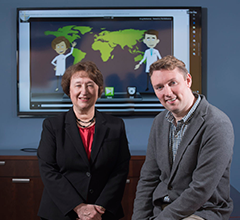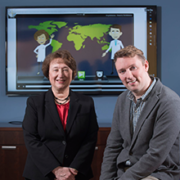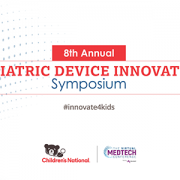Learning platform teaches clinicians how to spot and treat malaria

Children’s National experts are outlining a novel approach to helping healthcare providers learn how to diagnose and manage malaria; the online tool provides real-time feedback about their decision making.
Next-generation medical education looks like this: A white-coat wearing avatar with the voice, face, and know-how of one of the nation’s leading infectious disease experts walks you through the twists and turns of how to diagnose malaria, making stops in a variety of hospital settings. If you make the right diagnostic and treatment decisions, you get instantaneous gold stars. If your choices are off-the-mark, at each decision point you get a clear explanation of why your answer was incorrect.
“This is the future of medical education,” says Barbara Jantausch, M.D., F.A.A.P., F.I.D.S.A., an infectious disease specialist at Children’s National Health System. She’s the female avatar with the John Travolta dance moves and expertise about malaria’s epidemiology, diagnosis, and treatment.
Dr. Jantausch will present a poster, “The Hot Zone: An Online Decision-Centered Vignette Player for Teaching Clinical Diagnostic Reasoning Skills,” during IDWeek 2016, the annual meeting of the Infectious Diseases Society of America. “It’s case-based, interactive e-learning where you choose your own adventure. The beauty of this module is the training can be self-directed,” Dr. Jantausch adds.
“At Children’s National, we’re pioneering the effort to build discovery-based learning platforms,” says Jeff Sestokas, Director of eLearning. In the vignette player, he’s the male avatar named Dr. Bear. Malaria is the first infectious disease training module but others are planned for the global health series, including Chagas disease and Zika virus, Sestokas says.
Identifying the illness
According to the Centers for Disease Control & Prevention (CDC), in 2015 an estimated 214 million people around the world had malaria, a mosquito-borne illness, and 438,000 of them died. Because of the lengthy incubation period, many international travelers do not show malaria symptoms until they return to the United States and experience flu-like symptoms including high fevers, shaking chills, and dehydration. Their lab results may include metabolic acidosis, hypoglycemia, normocytic anemia, or thrombocytopenia. At Children’s, 25 percent of children admitted with travel-related malaria are admitted to the intensive care unit.
“This started as a way to offer people in areas that do not see as many patients with malaria an opportunity to learn the same critical thinking skills,” she adds.
People who click through the vignettes play the role of a clinician working in the emergency department whose patients include a 10-year-old girl who has just returned from vacation two weeks prior. The exhausted girl lies on a bed amid weeping parents and grandparents. She suffers from a headache and muscle pain and has a 39.8 C fever, though it spiked higher before her arrival at the ED.
“Because symptoms for malaria can mimic other infectious diseases, clinicians need to be able to recognize it in order to ask the most appropriate questions,” she says.
Making real-time decisions
In the vignette, participants are asked to type additional questions to help with diagnosis. Then, they select one of three geographic regions to explore in the 20-minute module in order to gain a better appreciation of the epidemiology of malaria, including the Plasmodium species that cause disease in those regions; to recognize a patient with symptoms of malaria; and to manage their care in keeping with the CDC’s guidance.
Within a few clicks, participants select the degree of the girl’s parasitemia, view slides from thick and thin blood smears, choose the medicine best suited for the parasite causing illness and geographic region the family visited, and decide on follow-up care.
“The timed sections force decision-making in real-world situations,” Sestokas adds. “Behind the scenes, we can look at how well clinicians recognize the subtleties prior to making their decisions and we provide feedback in real-time. Ultimately, our goal is to stimulate deliberate, reflective practices.”










